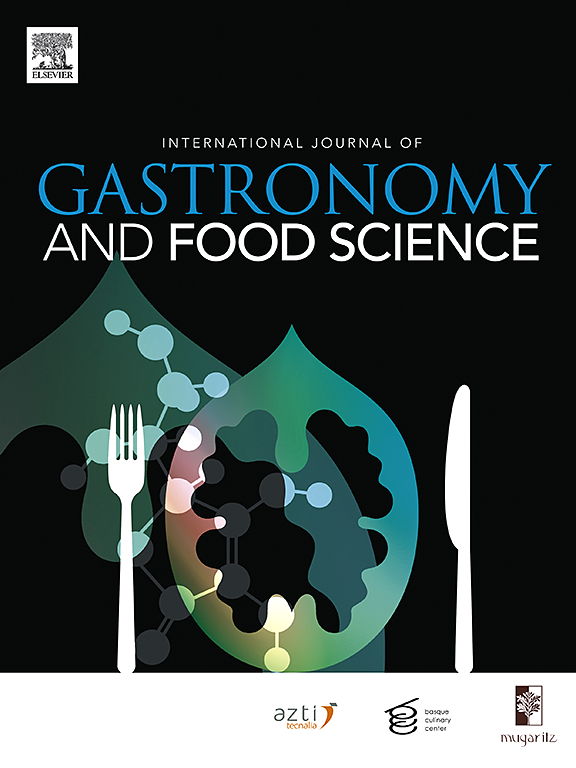Effect of bioactive compounds from culinary herbs against cholesterol thermo-oxidation in omelets during home cooking processes
IF 3.2
2区 农林科学
Q2 FOOD SCIENCE & TECHNOLOGY
International Journal of Gastronomy and Food Science
Pub Date : 2024-12-01
DOI:10.1016/j.ijgfs.2024.101077
引用次数: 0
Abstract
The prooxidant environment created during cooking induces cholesterol oxidation, compromising the safety of homemade foods. Thus, this study investigated the potential of basil and oregano as anti-cholesterol oxidation agents during omelet preparation by air frying and oil-free pan frying. Cooking induced cholesterol oxidation, as the content of cholesterol oxidation products (COPs) in control samples was higher after air frying (821.05 ± 13.77 μg/g) and pan frying (311.07 ± 13.84 μg/g) compared to the raw samples (40.69 ± 2.26 μg/g). However, both herbs effectively mitigated cholesterol oxide formation. While oregano yielded better results during air frying (from 152.04 ± 5.85 to 377.8 ± 6.4 μg/g of total COPs), similar effects were observed for both herbs in pan-fried samples (from 72.8 ± 7.7 to 272.1 ± 3.8 μg/g). UHPLC-ESI-MS analyses revealed the presence of antioxidants in herbs, primarily phenolic acids like p-Coumaric, vanillic, caffeic, and rosmarinic acids, but the impact of cooking on herbs’ antioxidant constituents was also demonstrated since some of them were no longer detected in cooked omelets containing the herbs. Despite it, this study suggests the use of basil and oregano as a viable method to minimize the formation and, consequent, consumption of cholesterol oxidation products.

求助全文
约1分钟内获得全文
求助全文
来源期刊

International Journal of Gastronomy and Food Science
Social Sciences-Cultural Studies
CiteScore
5.30
自引率
10.50%
发文量
170
审稿时长
45 days
期刊介绍:
International Journal of Gastronomy and Food Science is a peer-reviewed journal that explicitly focuses on the interface of food science and gastronomy. Articles focusing only on food science will not be considered. This journal equally encourages both scientists and chefs to publish original scientific papers, review articles and original culinary works. We seek articles with clear evidence of this interaction. From a scientific perspective, this publication aims to become the home for research from the whole community of food science and gastronomy.
IJGFS explores all aspects related to the growing field of the interaction of gastronomy and food science, in areas such as food chemistry, food technology and culinary techniques, food microbiology, genetics, sensory science, neuroscience, psychology, culinary concepts, culinary trends, and gastronomic experience (all the elements that contribute to the appreciation and enjoyment of the meal. Also relevant is research on science-based educational programs in gastronomy, anthropology, gastronomic history and food sociology. All these areas of knowledge are crucial to gastronomy, as they contribute to a better understanding of this broad term and its practical implications for science and society.
 求助内容:
求助内容: 应助结果提醒方式:
应助结果提醒方式:


